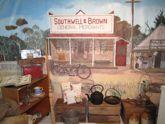Latest News
Visit by Suzanne Orr, Yerrabi MLA
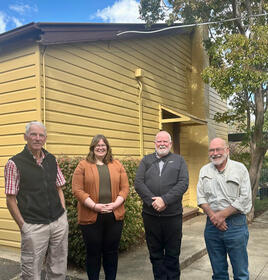
Local representative, MLA Suzanne Orr, has recently been appointed Labour Spokesperson for Heritage. To help her get across the interests and issues involved she spent two hours at the Heritage Centre... more »
National Trust Open Day at Yarralumla Woolshed
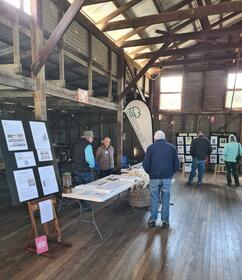
The National Trust Open Day event has become a much anticipated part of the annual ACT Heritage Festival. This year's event took place on Saturday 20th April at the old Yarralumla Woolshed, just down the... more »
Gillespie Exhibition launch
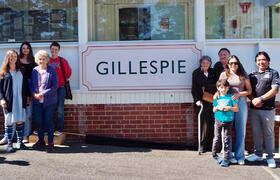
On Sunday 14 April large crowd attended the official naming of the Gillespie building and the launch of the Exhibition - 'The journey of Lyall Gillespie'. The exhibition was launched by Dr Roslyn Russell... more »
The latest addition to the centre's collection
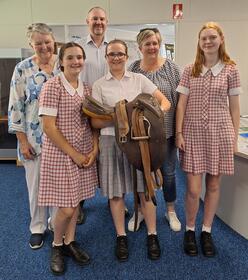
Over the past two weeks, following on from some excellent publicity, we have had especially large numbers of interested visitors coming to visit our 'Selected Southwell Stories' exhibition, keeping the... more »
An official street number at last
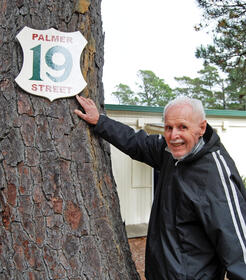
Most cities, towns and villages in Australia have an easily negotiated street system, with houses and commercial enterprises identified with a street number, so people looking for the buildings, or the... more »
Normal opening hours
- Every Thursday morning, 9.00 am - 12.00 noon
- Every Sunday afternoon, 12 noon - 4.00 pm
- by appointment (email: ) or 6230 9630.
Location
The Centre is located in the former Hall Primary School, 19 Palmer Street, Hall. Parking is on Palmer Street or Hoskins Street.
New Exhibition: The journey of Lyall Gillespie
A new exhibition about the life and work of eminent Canberra historian Lyall Gillespie will be officially opened on Sunday 14th April at 11.00 am. All welcome. There is no charge, but your donations are welcomed.
In 2015 the Hall Heritage Centre was invited to become the custodian of Lyall's lifetime collection. This exhibition draws extensively from that collection, and from items still held within the Gillespie family.
The official opening of the exhibition will be preceded immediately by the ceremonial naming of the building in which the collection is housed.
The exhibition is the main contribution of the Heritage Centre to the Canberra and Region Heritage Festival.
Explore heritage databases
Bush schools of the Canberra region
bush schools of the Canberra region locates and tells the stories of more than eighty one-teacher district bush schools and identifies nearly all of their teachers up to about 1940.
Rediscovering Ginninderra'
'Rediscovering Ginninderra' records prominent People and Places in the Ginninderra district (Belconnen plus Gungahlin) during the settlement era, illustrated by more than 400 photographs.
'From Ginin-ginin-derry to Hall'
Our main exhibition is a journey through time and space from Ginin-ginin-derry to Hall. 'Ginin-ginin-derry' was an aboriginal locality, first traversed by Europeans in the early 1820's and settled by them from around 1826, initially at 'Palmerville'. From the 1860's for half a century Ginninderra flourished, having its heyday in the 1890's and early 1900's when there was a church, school, post and telegraph office, blacksmith shop, police station, store, a nursery, and a boot-maker, Farmers Union, School of Arts, cricket club, and the large Ginninderra Estate.
A very productive agricultural area, Ginninderra supplied grain to the Araluen and Majors Creek goldfields, then wool to the Sydney markets. William Davis, then Tom Gribble, Edward Smith, Edmund Rolfe, 'Babe' Curran and others helped build a fine reputation for agriculture.
When Canberra was selected as the site for the capital and the new Federal government began resuming the land, Ginninderra's days were numbered. A new village site was proclaimed in 1882, and Hall began to grow into the kind of village that Ginninderra never quite became.
ANZAC : 'When Hall Answered the Call'+ 'Armistice and After'
'When Hall Answered the Call' commemorates the centenary of ANZAC. The original 2015 exhibition has since been scaled back, but the essence of it is preserved. Local soldiers' histories are fitted into the context of the Great War. A special feature of the exhibition is a re-created setting of a 'Welcome Home' ceremony that was held in the local Kinlyside Hall at the end of the war.
'Armistice and After', marking the centenary of the end of the Great War records the participation of the Hall district diggers in the triumphs of 1918, the euphoria that accompanied the end of hostilities and the difficulties of repatriation and adjustment to civilian life in a world where the promises of peace and prosperity never quite materialized.
A booklet by Allen Mawer 'When Hall Answered the Call' is available from the Centre ($10).
[See a review of the exhibition by Dr David Stephens at Honest History.
Annual Address - Eric Martin AM
Distinguished heritage architect Eric Martin gave the Centre's annual address on Thursday 27th October. An audio recording of his address can be downloaded here.
Some recent Visitor feedback :
- "Excellent in so many ways!"
- "Such a fantastic place, so many memories"
- "Genuinely fascinating – extraordinary effort"
- "What as impressive display!"
- "This is an amazing dislay of artefacts of the area"
- "Really interesting. Loved 'Memory Lane'"
- "Excellent exhibition on selector families"
- "Loved the schoolhouse – great exhibits"
- "I was quite taken aback by the depth of your collection"
We acknowledge the Traditional Custodians of the ACT, the Ngunnawal people. We acknowledge and respect their continuing culture and the contribution they make to the life of this city and this region.
